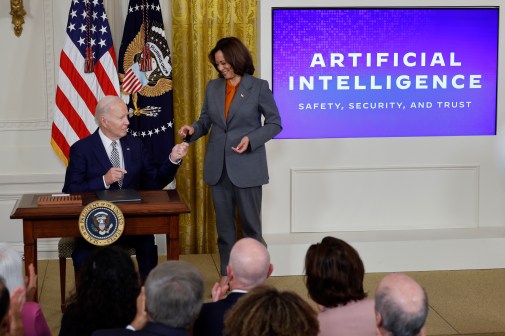The Defense Department released a new strategy Tuesday designed to enhance the ability of defense researchers and technologists to stay abreast of emerging innovations around the world and to better enable development partnerships with allies.
“Through increasing awareness and coordinated support of global technologies, we can establish and strengthen international science and technology partnerships,” wrote Alan Shaffer, the principal deputy in the Office of the Assistant Secretary of Defense for Research and Engineering, and Keith Webster, the Pentagon’s director of International Cooperation, in a letter accompanying the strategy.
“These partnerships are the foundation for improving U.S. capabilities and interoperability, mitigating existing or emerging threats, supporting coalition operations, strengthening the technological basis for joint humanitarian assistance and disaster recovery, and moreover, promoting global security to protect the homeland,” they wrote.
The new “International S&T Engagement Strategy” seeks to establish a common baseline of knowledge about global developments in more than 17 research areas deemed critical to national defense and make that database of information available across so-called “communities of interest” — technical groups of subject matter experts responsible for studying specific areas of defense research.
 The 17 research areas deemed critical to national defense that will form the basis of the Pentagon’s research communities of interest. (Source: International S&T Engagement Strategy, 2014.)
The 17 research areas deemed critical to national defense that will form the basis of the Pentagon’s research communities of interest. (Source: International S&T Engagement Strategy, 2014.)Pentagon officials acknowledged the two main drivers behind the strategy are the pace of technological change around the world and the budget pressures facing the department. As the military begins its strategic rebalancing toward the Asia-Pacific region, the Pentagon is being forced to forge new alliances and relationships to deal with emerging operational environments in which no single country is likely to have a decisive advantage, such as cyberspace, electronic warfare and big data analytics.
According to studies by the Atlantic Council, independent research and development spending among U.S. defense contractors is declining compared to the investments at leading global defense firms. In fact, recent statistics show more than one-third of all defense procurement dollars in the U.S. went to commercial or international companies. And now new questions are emerging about the Pentagon’s ability to overcome its aversion to global sourcing of technologies.
 Former Deputy Defense Secretary William J. Lynn III speaking July 8 at the Atlantic Council on the globalization of the U.S. defense industry.
Former Deputy Defense Secretary William J. Lynn III speaking July 8 at the Atlantic Council on the globalization of the U.S. defense industry.Former Deputy Defense Secretary William J. Lynn III, who’s now the CEO of Finmeccanica North America and DRS Technologies Inc., said the budget realities now facing the Pentagon and the changes taking place on the global technology front may force fundamental changes in the U.S. defense industry, particularly its approach to globalization.
“It’s a much more nuanced world. I think we’re moving into the fourth defense industrial base era.,” Lynn said, speaking July 8 during the Atlantic Council’s Captains of Industry speaking series. To get the technologies we need, “you’re going to have to do global sourcing,” he said.
The six major companies that now dominate the U.S. defense industry, meanwhile, are not investing their cash in technology research and development. According to Lynn, R&D capital expenses have been flat for the past decade and may only now be starting to trend upward.
“We need to look frankly at greater consolidation. We are seeing a more global defense industry. That, I would argue, is a good thing. Not all the best technology is U.S.,” Lynn said. But those are not popular concepts in the Pentagon and in the executive suites of U.S. industry, he said.
“They should not fight this,” Lynn said, likening the current situation in the defense market to what the auto industry experienced in the early 1980s when it was considered unpatriotic to not buy an American car. “Today, Honda builds more cars in the U.S. than it does in Japan. This is the kind of path that the defense industry is going to have to go down. DOD is going to need to adapt.” Follow @DanielVerton




